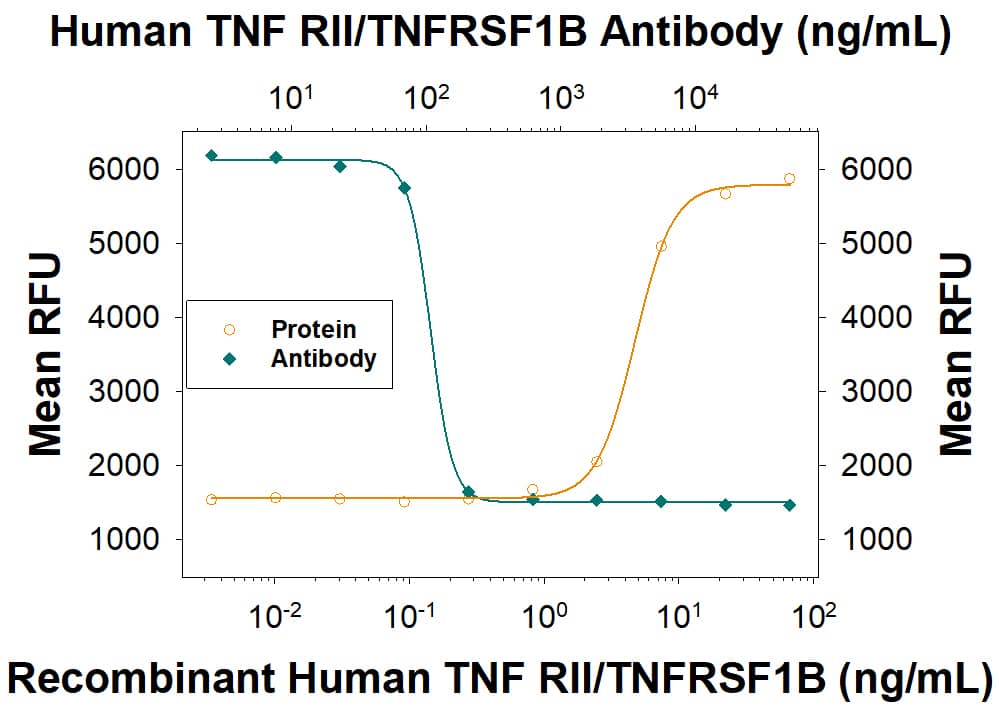Human Erythropoietin/EPO Antibody Summary
Customers also Viewed
Applications
Please Note: Optimal dilutions should be determined by each laboratory for each application. General Protocols are available in the Technical Information section on our website.
Scientific Data
 View Larger
View Larger
Cell Proliferation Induced by Erythropoietin/EPO and Neutralization by Human Erythropoietin/EPO Antibody. Recombinant Human Erythropoietin/EPO (Tissue Culture Grade) (Catalog # 287-TC) stimulates proliferation in the TF-1 human erythroleukemic cell line in a dose-dependent manner (orange line) as measured by Resazurin (Catalog # AR002). Proliferation elicited by Recombinant Human Erythropoietin/EPO (Tissue Culture Grade) (0.2 units/mL) is neutralized (green line) by increasing concentrations of Rabbit Anti-Human Erythropoietin/EPO Polyclonal Antibody (Catalog # AB-286-NA). The ND50 is typically <3 µg/mL.
 View Larger
View Larger
Erythropoietin/EPO in Human Kidney. Erythropoietin/EPO was detected in immersion fixed paraffin-embedded sections of human kidney using Rabbit Anti-Human Erythropoietin/EPO Polyclonal Antibody (Catalog # AB-286-NA) at 15 µg/mL for 1 hour at room temperature followed by incubation with the Anti-Rabbit IgG VisUCyte™ HRP Polymer Antibody (Catalog # VC003). Tissue was stained using DAB (brown) and counterstained with hematoxylin (blue). Specific staining was localized to convoluted tubules. View our protocol for IHC Staining with VisUCyte HRP Polymer Detection Reagents.
Preparation and Storage
- 12 months from date of receipt, -20 to -70 °C as supplied.
- 1 month, 2 to 8 °C under sterile conditions after reconstitution.
- 6 months, -20 to -70 °C under sterile conditions after reconstitution.
Background: Erythropoietin/EPO
Erythropoietin (EPO) is a 34 kDa glycoprotein hormone in the type I cytokine family and is related to thrombopoietin. Its three N-glycosylation sites, four alpha helices, and N- to C-terminal disulfide bond are conserved across species. Glycosylation of EPO is required for biological activities in vivo. Mature human EPO shares 75%‑84% amino acid sequence identity with bovine, canine, equine, feline, mouse, ovine, porcine, and rat EPO. Epo is primarily produced in the kidney by a population of fibroblast-like cortical interstitial cells adjacent to the proximal tubules. It is also produced in much lower, but functionally significant amounts by fetal hepatocytes and in adult liver and brain. EPO promotes erythrocyte formation by preventing the apoptosis of early erythroid precursors which express the EPO receptor (EPO R). EPO R has also been described in brain, retina, heart, skeletal muscle, kidney, endothelial cells, and a variety of tumor cells. Ligand induced dimerization of EPO R triggers JAK2-mediated signaling pathways followed by receptor/ligand endocytosis and degradation. Rapid regulation of circulating EPO allows tight control of erythrocyte production and hemoglobin concentrations. Anemia or other causes of low tissue oxygen tension induce EPO production by stabilizing the hypoxia-induceable transcription factors HIF-1 alpha and HIF-2 alpha. EPO additionally plays a tissue-protective role in ischemia by blocking apoptosis and inducing angiogenesis.
Product Datasheets
Citations for Human Erythropoietin/EPO Antibody
R&D Systems personnel manually curate a database that contains references using R&D Systems products. The data collected includes not only links to publications in PubMed, but also provides information about sample types, species, and experimental conditions.
7
Citations: Showing 1 - 7
Filter your results:
Filter by:
-
Development of a VHH-Based Erythropoietin Quantification Assay
Authors: Stefan Kol, Thomas Beuchert Kallehauge, Simon Adema, Pim Hermans
Molecular Biotechnology
-
Effect of erythropoietin on angiogenic potential of dental pulp cells
Authors: Qimei Gong, Junyu Zeng, Xufang Zhang, Yihua Huang, Chanchan Chen, Jingjing Quan et al.
Experimental and Therapeutic Medicine
-
Immunohistochemical and transcriptome analyses indicate complex breakdown of axonal transport mechanisms in canine distemper leukoencephalitis.
Authors: Spitzbarth I, Lempp C, Kegler K et al.
Brain Behav.
-
Expression of functionally active sialylated human erythropoietin in plants
Authors: Jakub Jez, Alexandra Castilho, Josephine Grass, Karola Vorauer‐Uhl, Thomas Sterovsky, Friedrich Altmann et al.
Biotechnology Journal
-
Modified recombinant human erythropoietin with potentially reduced immunogenicity
Authors: T Susantad, M Fuangthong, K Tharakaram, P Tit-Oon, M Ruchirawat, R Sasisekhar
Scientific Reports, 2021-01-15;11(1):1491.
Species: Human
Sample Types: Protein
Applications: ELISA Detection, Western Blot -
Continuous Translation of Circularized mRNA Improves Recombinant Protein Titer
Authors: A Costello, NT Lao, N Barron, M Clynes
Metab. Eng., 2019-01-04;0(0):.
Species: Transgenic Hamster
Sample Types: Cell Lysates
Applications: Western Blot -
Practical recombinant hybrid mussel bioadhesive fp-151.
Authors: Hwang DS, Gim Y, Yoo HJ, Cha HJ
Biomaterials, 2007-05-03;28(24):3560-8.
Species: Human
Sample Types: Whole Cells
Applications: ICC
FAQs
-
Does the human Erythropoietin (Epo) polyclonal antibody (Catalog # AB-286-NA) bind Epo if the receptor is not present?
AB-286-NA binds Epo if the receptor is not present.
Reviews for Human Erythropoietin/EPO Antibody
There are currently no reviews for this product. Be the first to review Human Erythropoietin/EPO Antibody and earn rewards!
Have you used Human Erythropoietin/EPO Antibody?
Submit a review and receive an Amazon gift card.
$25/€18/£15/$25CAN/¥75 Yuan/¥2500 Yen for a review with an image
$10/€7/£6/$10 CAD/¥70 Yuan/¥1110 Yen for a review without an image
















